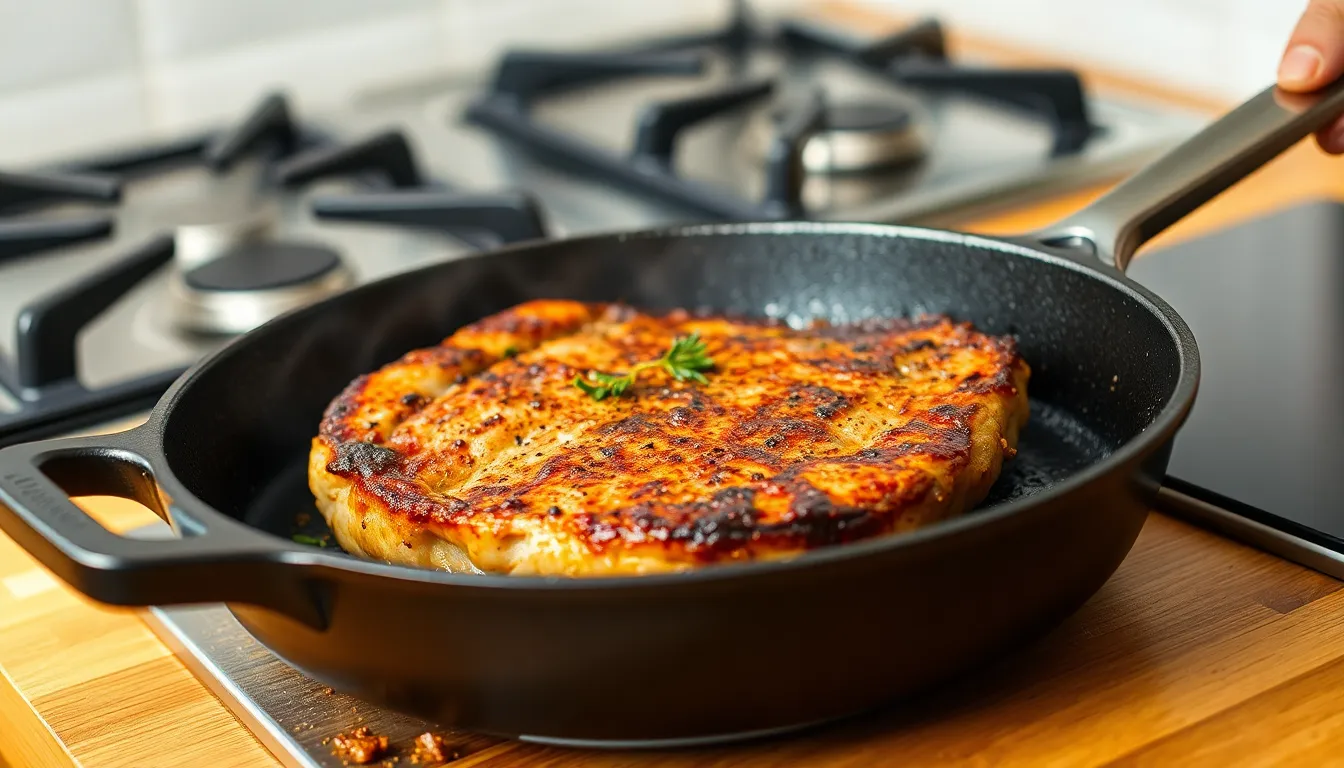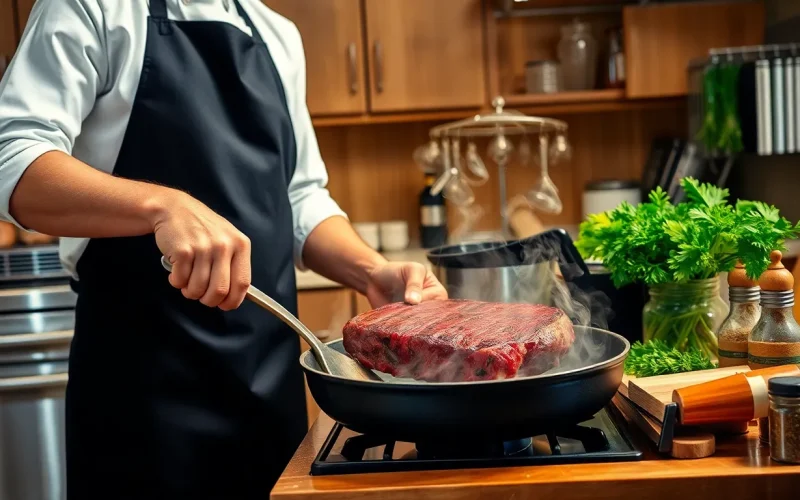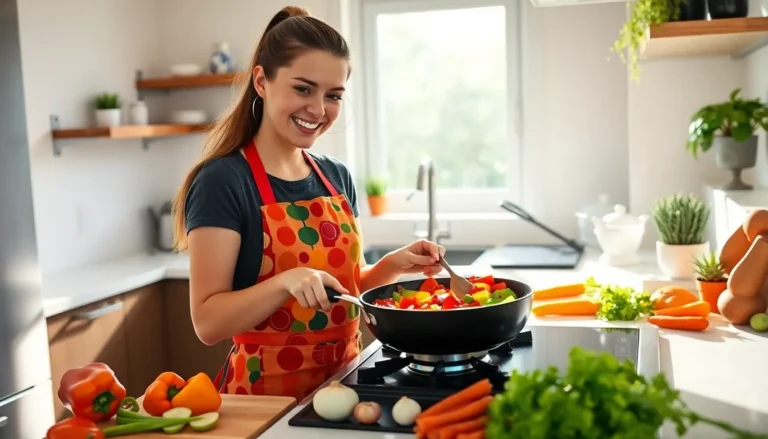Table of Contents
ToggleWhen it comes to cooking steak, the options are as varied as the cuts themselves. Whether it’s sizzling on the grill or searing in a pan, mastering the art of steak cooking can turn a regular meal into a culinary masterpiece. But let’s be honest—who hasn’t faced the daunting task of cooking the perfect steak and ended up with something resembling a shoe sole?
Overview of Steak Cooking Techniques
Steak cooking techniques vary significantly, each offering unique flavors and textures. Grilling remains one of the most popular methods, typically involving high heat and direct flames. This approach enhances the beef’s natural juices while imparting a smoky flavor.
Pan-searing is another effective technique that involves cooking steak in a hot skillet. This method creates a rich, caramelized crust while sealing in moisture. Cookers often choose cast iron or stainless steel pans for optimal heat retention.
Sous vide offers precision that traditional methods cannot match. By vacuum-sealing steak and cooking it in a water bath, chefs achieve consistent results. This technique allows for precise temperature control and tender meat without the risk of overcooking.
Broiling uses high heat from above to cook steak. This method is similar to grilling, but cooks from above rather than below. Broilers create a nice char on the surface while keeping the inside juicy.
Cooking steak in the oven is also effective. The combination of dry heat helps to achieve even cooking throughout. Adding a finish on the stovetop enhances flavor and texture.
Each technique serves different purposes, such as preference for flavor, tenderness, and cooking time. Understanding these variations helps home cooks select the right technique to achieve the desired outcome. Exploring these methods contributes to culinary skill development, ensuring steak lovers don’t face those common cooking challenges.
Searing Techniques

Searing techniques enhance flavor through the Maillard reaction, which develops a savory crust. Two popular methods are pan-searing and grilling, each offering unique benefits.
Pan-Searing
Pan-searing involves cooking steak in a hot skillet, typically using a small amount of oil. Starting with a cast-iron or stainless-steel pan ensures even heat distribution. Achieving the desired crust requires high heat, followed by careful timing. After heating the oil until it shimmers, placing the steak in the pan creates a rich golden-brown crust. Using tongs, flipping the steak promotes even cooking on all sides. For thicker cuts, finishing the steak in the oven allows the interior to reach the perfect doneness without overcooking the exterior. This technique works well for ribeye and filet mignon.
Grilling
Grilling steaks over an open flame produces a distinctive smoky flavor while leaving attractive grill marks. Preheating the grill to high heat ensures proper searing as the steak makes contact with the grates. Oil the grates lightly to prevent sticking. Placing the steak diagonally across the grates maximizes sear marks. Flipping the steak only once helps create a crust while retaining juices. For thicker steaks, close the lid to maintain heat for even cooking. Adjusting the position of the steak allows for control over the cooking process. Grilling works especially well for sirloin and T-bone steaks.
Sous Vide Method
Sous vide provides precise temperature control, ensuring uniform cooking and consistently tender steak. This technique involves vacuum-sealing steak in a bag and immersing it in a water bath at a specific temperature.
Benefits of Sous Vide
Sous vide offers several advantages for cooking steak. First, it guarantees even cooking throughout the meat, eliminating overcooked edges and undercooked centers. Second, flavor infusion occurs as the steak absorbs seasonings during the cooking process. Third, the method enhances tenderness, breaking down proteins without drying out the meat. Fourth, a longer cooking time allows chefs to use cheaper cuts without compromising quality. Lastly, sous vide reduces the risk of failure, making it easier for home cooks to achieve professional results.
Step-by-Step Guide
- Choose a high-quality steak, such as ribeye or filet mignon, for optimal flavor.
- Season the steak generously with salt and pepper or preferred spices.
- Place the steak in a vacuum-seal bag, ensuring minimal air is trapped inside.
- Preheat a water bath to the desired temperature, typically between 129°F to 134°F for medium-rare.
- Immerse the sealed bag into the water bath, cooking for 1 to 4 hours based on thickness and preference.
- Once finished, remove the steak from the bag and pat it dry with paper towels.
- Sear the steak in a hot skillet or on a grill for about 1 minute per side to develop a tempting crust.
Oven-Based Techniques
Several effective oven-based methods exist for cooking steak. Roasting and broiling allow cooks to achieve desired textures and flavors without excessive effort.
Roasting
Roasting employs indirect heat to cook steak evenly. Cooks often preheat the oven to temperatures between 400°F and 450°F. Seasoning the steak generously with salt and pepper enhances its natural flavor. Placing the steak on a roasting pan allows for air circulation, promoting uniform cooking. Typical roasting times vary based on thickness; for example, a 1-inch steak may require about 20 to 25 minutes. Checking the internal temperature ensures doneness: 130°F for medium-rare, 140°F for medium, and 160°F for well-done. Resting the steak for several minutes post-roasting allows the juices to redistribute, resulting in a tender bite.
Broiling
Broiling cooks steak using high direct heat from above. Setting the oven to broil at around 500°F provides optimal conditions for this technique. A broiler pan or cast iron skillet helps retain juices while allowing fat to drip away. Positioning the steak 3 to 4 inches from the heat source ensures a charred exterior and a juicy interior. This technique requires careful monitoring; a 1-inch steak may take about 6 to 8 minutes per side for medium-rare. Using a meat thermometer to check for doneness guarantees precision. Following a brief rest period lets flavors settle, creating an enjoyable dining experience.
Tips for Perfecting Your Steak
Selecting the right cut of steak is crucial for achieving the desired outcome. Ribeye provides rich marbling, enhancing flavor, while filet mignon offers tenderness. Opt for quality meat, ideally graded choice or prime, for superior results.
Seasoning matters significantly. Generously season with salt and pepper; this step enhances flavor and creates a delicious crust. Allow the steak to sit at room temperature for about 30 minutes before cooking, promoting even cooking.
Preheating the cooking surface is essential. A hot grill or skillet allows for optimal searing, which locks in juices and creates a flavorful caramelized crust. Maintain high heat for grilling, and ensure medium-high heat for pan-searing to achieve perfect results.
Timing influences tenderness and juiciness. For medium-rare, aim for an internal temperature of 135°F. Use a meat thermometer for accuracy, checking the temperature at the thickest part of the steak.
Resting is a vital step after cooking. Let the steak rest for 5 to 10 minutes before slicing. This practice allows juices to redistribute, ensuring a moist and flavorful eating experience.
Finishing touches elevate the dish. Adding a pat of herb butter or a drizzle of garlic oil after cooking can enhance flavor profiles. Consider serving the steak with sides like roasted vegetables or mashed potatoes for a complete meal.
Experimenting with cooking techniques enhances skills. Trying various methods such as sous vide or broiling can provide new textures and flavors. Consistently practicing these tips leads to improvements, making each steak dinner a worthy endeavor.
Mastering steak cooking techniques can transform a simple meal into a culinary delight. Each method offers unique advantages that cater to different tastes and preferences. Whether it’s the smoky flavor from grilling or the precision of sous vide, there’s a technique for every home cook.
By understanding the nuances of each approach and experimenting with various cuts and seasonings, anyone can elevate their steak game. Remember the importance of resting the steak and adding finishing touches to enhance flavor. With practice and confidence, achieving the perfect steak is within reach. Enjoy the journey of cooking and savor the delicious results.





